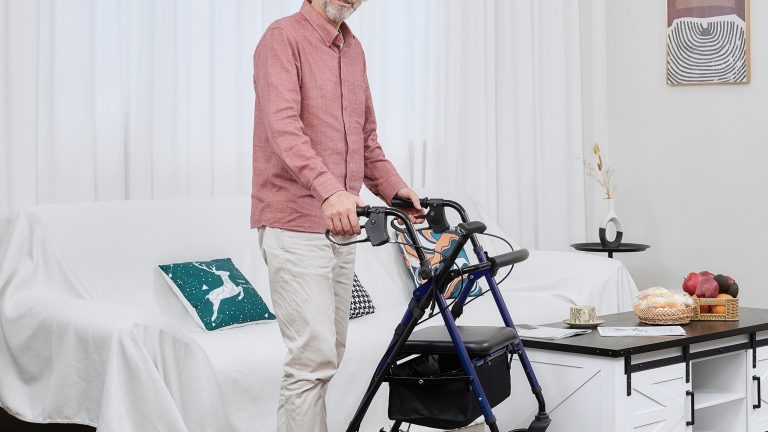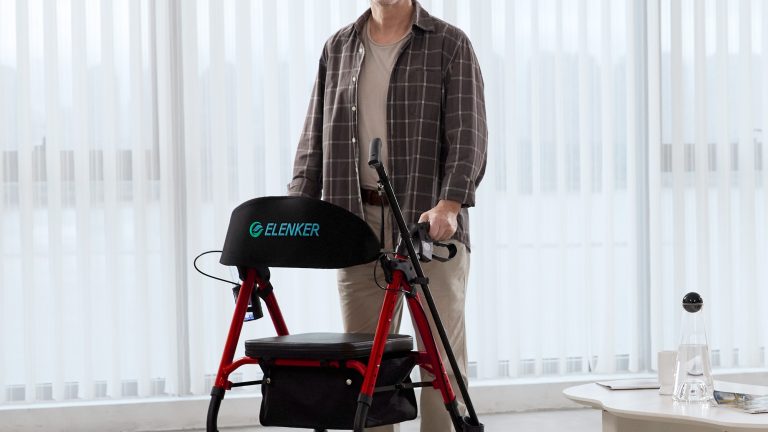If you’re dealing with a leg injury, staying mobile can be a challenge. You might be wondering if a rollator walker is the right solution for you. After all, rolling walkers provide support, balance, and even a comfy seat when you need to rest. But is a rollator walker with seat a good choice when you have an injured leg? The short answer: It depends on your injury.
Let’s break it down and see if a rollator is the best option for you, or if another type of mobility aid—like crutches or an Elenker scooter—might work better.
What Is a Rollator Walker?
A rollator walker is a type of walking aid with four wheels, hand brakes, and often a built-in seat. Unlike traditional walkers that require lifting, a rolling walker moves smoothly, making it easier to get around without heavy effort.
Many people love walkers with seats because they allow you to take a break whenever needed. Brands like Elenker walker offer lightweight, foldable options that are easy to maneuver.
But just because a rollator is convenient doesn’t mean it’s right for every situation—especially when dealing with a leg injury.
When Can You Use a Rollator with a Leg Injury?
A rollator walker with seat might work for you if:
✔ You have a minor leg injury. If you’re dealing with mild pain, a strain, or a sprain but can still put weight on your leg, a rolling walker could help with balance and reduce strain.
✔ You need support, not full weight-bearing relief. A rollator walker is best for people who need extra stability but can still use both legs. If you need to keep weight completely off one leg, a rollator isn’t the right choice.
✔ You’re recovering from surgery but allowed some movement. If your doctor says you can walk with light assistance, a walker with seat can help you stay mobile while giving you a place to rest when needed.
✔ You need help with endurance. If your leg injury makes walking tiring, but you don’t need total non-weight-bearing support, a rollator walker lets you move around with less effort.
When Is a Rollator NOT a Good Idea?
A rolling walker is NOT the best choice if:
🚫 You can’t put weight on your injured leg. Rollators are designed to assist with balance and mobility, not to completely offload weight. If your injury requires full non-weight-bearing support, a rollator won’t work.
🚫 You have a broken leg, severe sprain, or post-surgery restrictions. If your doctor has told you to avoid putting pressure on your leg, a rollator isn’t safe. You need something that completely keeps weight off the injury.
🚫 You have poor upper body strength. Rollators provide light support, but they don’t bear your full weight like crutches or a knee scooter. If you struggle to support yourself, another aid may be better.
🚫 You need to navigate stairs often. A rollator walker is not ideal for stairs. If you live in a place with lots of steps and no ramps, a different mobility aid might be necessary.
What Are Better Alternatives?
If a rollator walker isn’t the right fit for your leg injury, here are some better options:
1. Elenker Scooter (Knee Scooter)
A knee scooter, like the Elenker scooter, is a great choice for leg injuries where you need to completely avoid weight-bearing on one leg. You rest your injured leg on the padded knee platform and push yourself forward with your good leg.
✔ Perfect for broken feet, ankle injuries, or post-surgery recovery.
✔ Provides full weight relief while keeping you mobile.
✔ Easier and more stable than crutches.
2. Crutches
Traditional crutches keep all weight off your injured leg but require upper body strength. They’re a good option for short-term injuries but can be tiring for long-term use.
✔ Good for non-weight-bearing injuries.
✔ Lightweight and portable.
✔ Can be tough on the arms and shoulders.
3. A Walker (Without Wheels)
If you need more stability than a rollator walker but don’t want crutches, a standard walker (without wheels) might work better. These allow you to move forward step by step while fully supporting your weight.
✔ Provides more support than a rollator.
✔ Good for post-surgery recovery.
✔ Requires more effort to lift and move.
Should You Use a Rollator with a Leg Injury?
It all comes down to how much weight you can put on your injured leg.
✔ If you have a minor leg injury and need light support, a rollator walker with seat can help you move safely.
✔ If you can’t put weight on your leg at all, an Elenker scooter (knee scooter) or crutches are much better choices.
✔ If you need extra stability but still want to walk, a standard walker without wheels might be best.
Before choosing a rollator walker or any mobility aid, talk to your doctor or physical therapist to make sure it’s the right fit for your injury.
At the end of the day, the goal is safe, comfortable mobility—so choose what helps you move with confidence!



